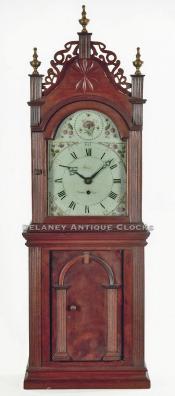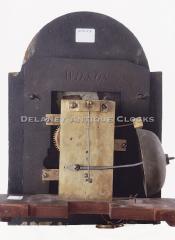David Wood of Newburyport, Massachusetts. Shelf clock. 213058.
Newburyport, Massachusetts, certainly has its share of accomplished clockmakers. Names that quickly come to mind include Mulliken, Balch, and David Wood. This historic city, the center of which is located on the south side of the mighty Merrimac River, is approximately three miles from the ocean.
David Wood was born the son of John and Eunice Wood in Newburyport, Massachusetts, on July 5, 1756. It is thought that he may have been apprenticed to Daniel Balch Senior or one of the members of the Mulliken family. All of them were prominent clockmakers in this region. On June 13, 1792, David advertised that he had set up a Market Square shop near Reverend Andrews Meeting House, where he made and sold clocks. Three years later, he married Elizabeth Bird in 1795. It becomes evident that David Wood was also a Retailer. In 1806, he advertised that he had for sale “Willard’s best Patent Timepieces, for as low as can be purchased in Roxbury.” In 1818, he and Abel Moulton, a local silversmith, moved into the shop formerly occupied by Thomas H. Balch. In 1824, he advertised that he had moved to the westerly side of Market Square opposite the Market House. After his wife died in 1846, he moved to Lexington to live near his son David, a merchant in that town. It has become quite obvious to us that David Wood was a very successful Clockmaker and Retailer of Clocks. Over the last 55-plus years of selling clocks, we have sold many examples of wall, shelf, and tall case clocks bearing this Maker’s signature on the dial.
The Massachusetts shelf clock can be loosely categorized into four forms that are most often described by the shape and construction of the dial. The earliest examples of the form feature dials generally constructed in brass and are decorated with engraved details such as floral themes and geometric patterns. These are engraved into the front surface of the dial. Often, these dials were finished in a silver wash. This dial transitions into the painted dial form, a significant development in clockmaking that allowed for more colorful and intricate designs. The painted dial is frequently colorfully decorated. The first versions of these were arched forms sharing the same shape found on most tall clocks of the same period. Please keep in mind that shelf clock dials are almost always smaller in scale. This traditional shape evolved into what the trade calls the “Kidney” form, a unique design that became popular in the late 18th century. These dials are rounded at the top and turn in before they turn back out again at the bottom. The added space below the time ring is the area where the Clockmaker often signed his work. The last of the dial shapes is the circular painted dial. More often than not, it is a convex form. These clocks that share this late dial form were produced in the most significant numbers. Please keep in mind that as the dial shape changed, so did the cases that housed them.
Early case examples are generally decorated with applied moldings to the extent that they are called architectural cases. Very few of these are found in the marketplace and, as a result, are not easily found pictured in books. To my knowledge, the only reference with multiple examples pictured is Diston & Bishop’s The American Clock. As the form progresses, the cases start to incorporate veneers and inlays. The construction decorations resemble those found in tall clock construction of contemporary clocks. This again changes to a case that features eglomise’ tablets. These tablets are very colorful and depict many themes. It is this last form that was made in quantity.
This is a truly exceptional Massachusetts shelf clock. It is an early form with an architecturally featured case, a rare find for any collector. The case, constructed in mahogany, features a beautifully painted arched dial signed by the renowned David Wood of
Newburyport, Massachusetts. This unique piece, made circa 1795, is so dated on the dial, adding to its historical significance and rarity.
The case is constructed in mahogany and retains an older finish and a wonderful mellow patina. It is supported by an applied molding that rests flat on the surface it is placed on. The lower section is fitted with a large door. This door features a series of applied moldings that form an arch. They consist of two fluted columns applied to the lower two-thirds of the door. They are mounted in a vertical position parallel to each other. Both columns are capped with wooden moldings at each end. Each supports one end of an arch molding that connects them. One would open this door to gain access to the lead weight and the pendulum. The sides of this lower section are decorated with additional fluted columns or moldings. The horizontal moldings that separate the base and the hood are complex. This supports the hood section. The door is an interesting form in that it incorporates a breakarch surmounted by a stylized pagoda that supports an applied New England style pierced and open fretwork. The frets are a free-flowing design. They are attached to the three fluted finial plinths. Each is capped at the top and supports a brass finial. The pagoda is also framed with fluted molding at each end. In the center or at the top of the bell is a carved pinwheel that dominates the front facade. Large tombstone-shaped side lights or windows are located on the sides of the bonnet. These are fitted with glass. The long fluted columns that flank the hood door are attached to it. One would open this door to access the dial.
This iron dial, a significant part of the clock's history, is very colorfully painted and of English origin. It was manufactured and painted by the Wilson Dial Manufactory (1777-1809) in Birmingham, England, a firm that was in the business of painting dials for the English and American markets. In their day, they were the dominant player, and their influence is evident in the quality of this dial. Measuring approximately 9.5 inches tall and 7 inches wide, it features a signed Wilson false plate and is skillfully decorated on the front with flowers and berries. The quality of the artistry is excellent, a true reflection of the craftsmanship of the time. This dial is signed “Wood / Newburyport,” Adding to its historical significance. The time track is formatted in both Roman and Arabic numerals, a common practice of the time. Roman numerals are used to mark the hours, while Arabic numerals are used to indicate each of the five-minute markers. The iron hands, hand-filed and gracefully formed, are a testament to the skill of the clockmaker.
The brass movement is of good quality. Two cast brass plates are supported by four decoratively turned posts. Brass gearing and hardened steel pinions make up the time train. This movement is weight-driven and designed to run for approximately eight days on a full wind. It is fitted with a fall-off strike, which means that it will strike once every hour. The bell is supported by a bell stand mounted to the back plate of the movement.
This clock stands approximately 33 inches tall. It is 11 inches wide and 5.75 inches deep.
Inventory number 213058.
David Wood was born the son of John Wood (1727-1805) and Eunice (Fellows) Wood (1737-1801) in Newburyport, Massachusetts, on July 5, 1766. It is thought that he may have been apprenticed to either Daniel Balch Senior or to one of the members Mulliken family. All of whom were prominent Clockmakers in this region. David advertised in the Essex Journal and New Hampshire Packet on June 13, 1792, that he had set up a shop in Market Square, near Reverend Andrews Meeting House. Three short years later, he married Elizabeth Bird (1769-1846) of Newbury in 1795. It has become evident that David Wood was also a Retailer. In 1806 he advertised that he had for sale "Willard's best Patent Timepieces, for as low as can be purchased in Roxbury." In 1818, he and Abel Moulton, a local silversmith, moved into the shop formerly occupied by Thomas H. Balch. In 1824 he advertised that he had moved on the westerly side of Market Square opposite the Market House. After his wife's death in 1846, he moved to Lexington to live near his son David, who was a merchant in that town.
It has become quite obvious to us that David Wood was a very successful Clockmaker and Retailer of Clocks. Over the last 35 years of being in the business of selling clocks, we have sold many examples of wall, shelf, and tall case clocks bearing this Maker's signature on the dial.
















